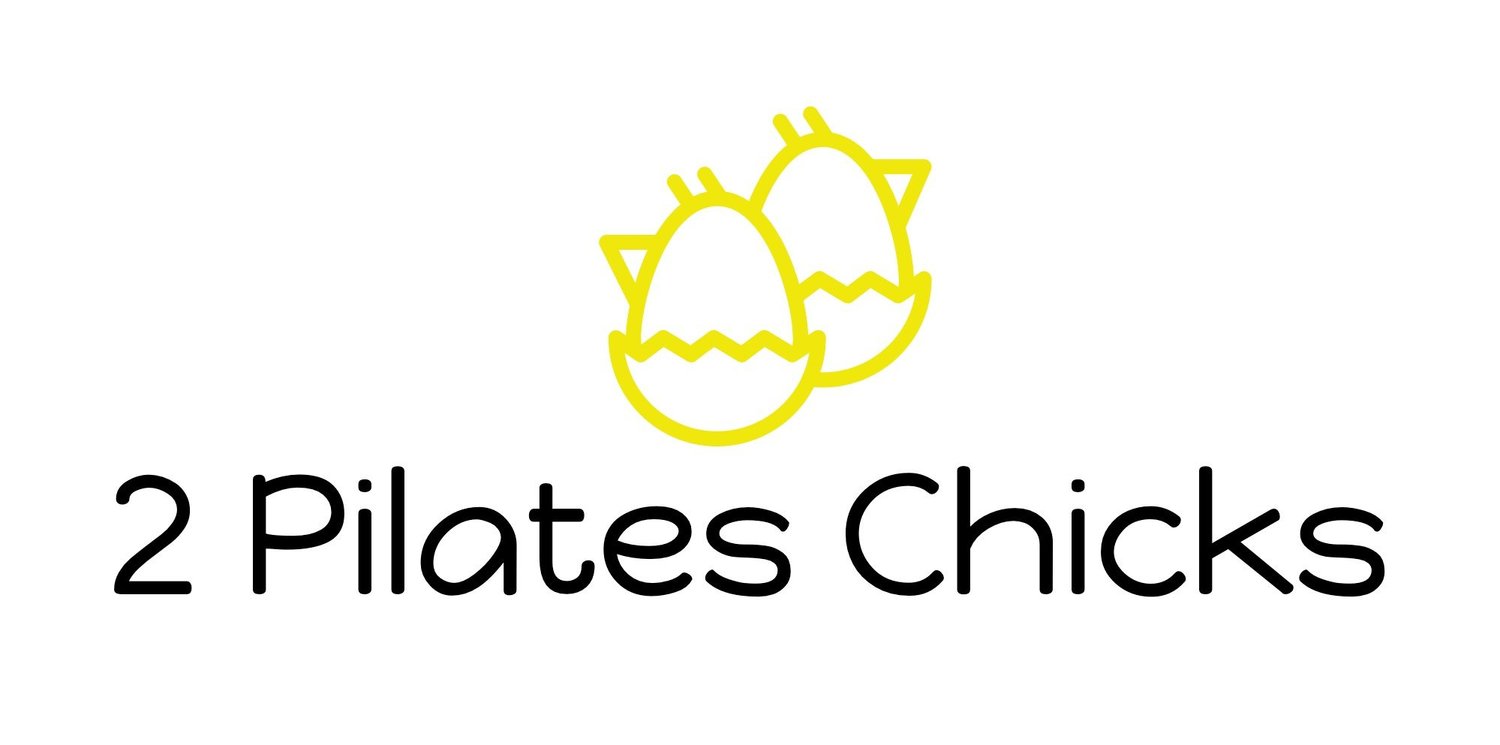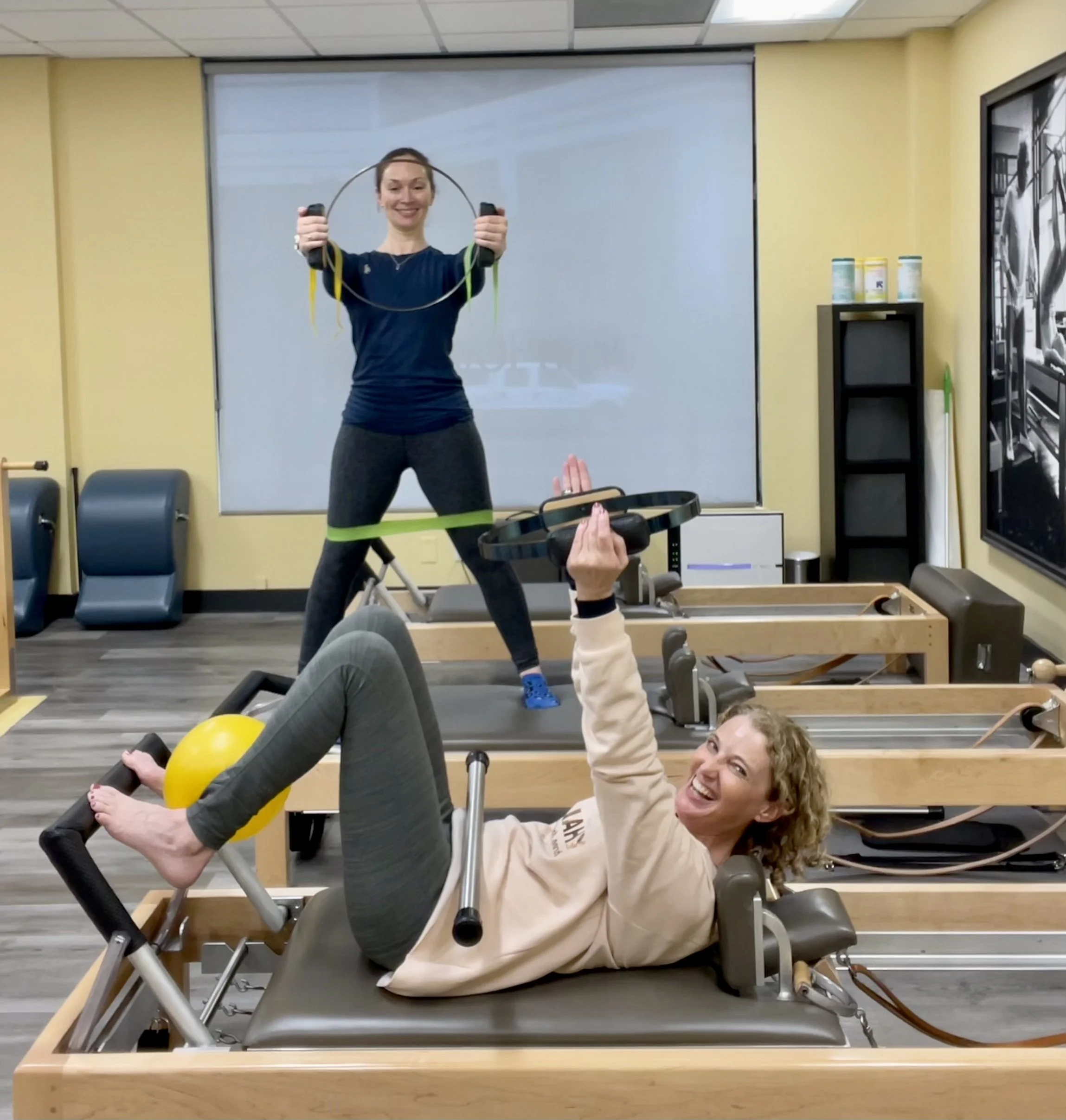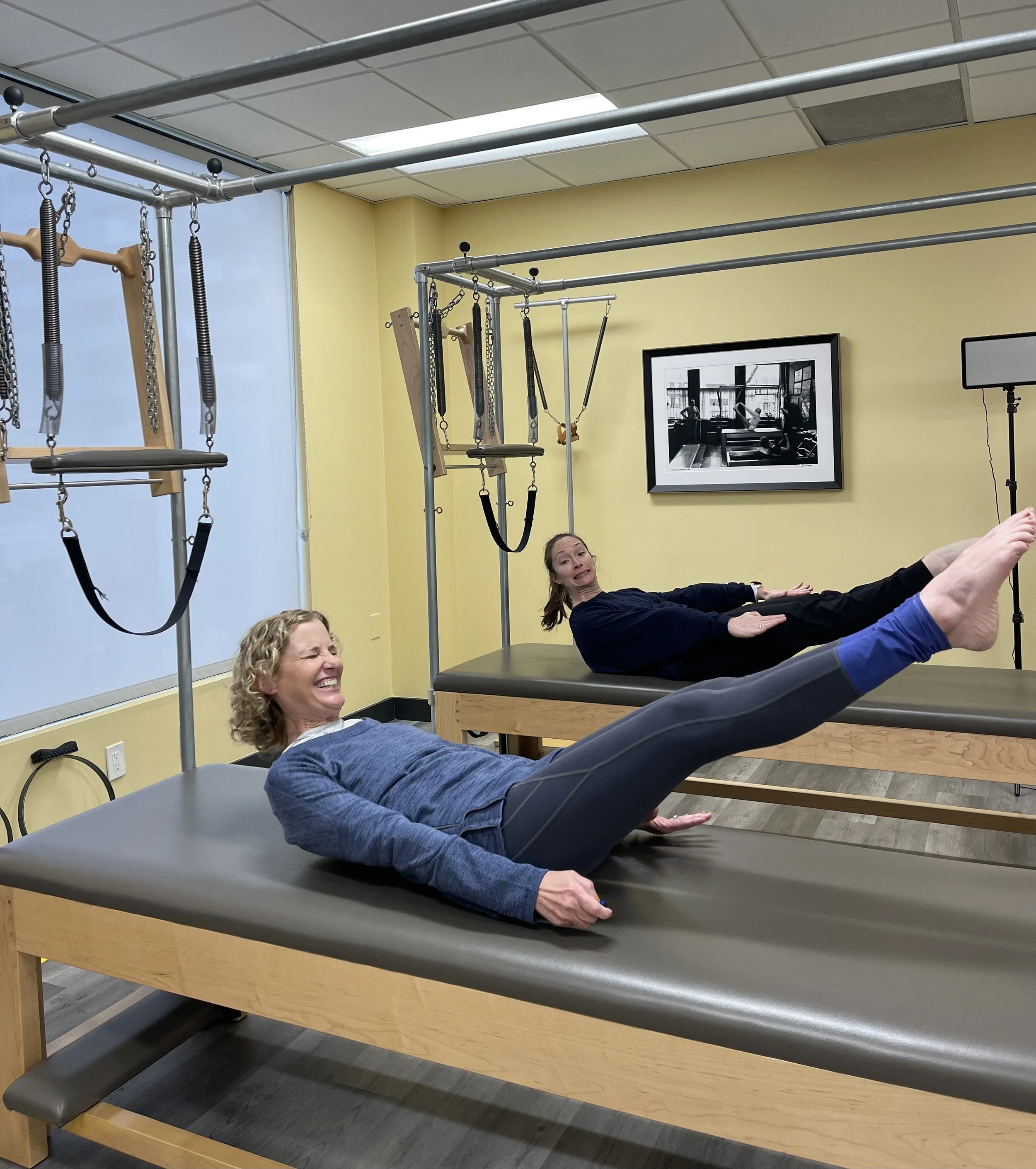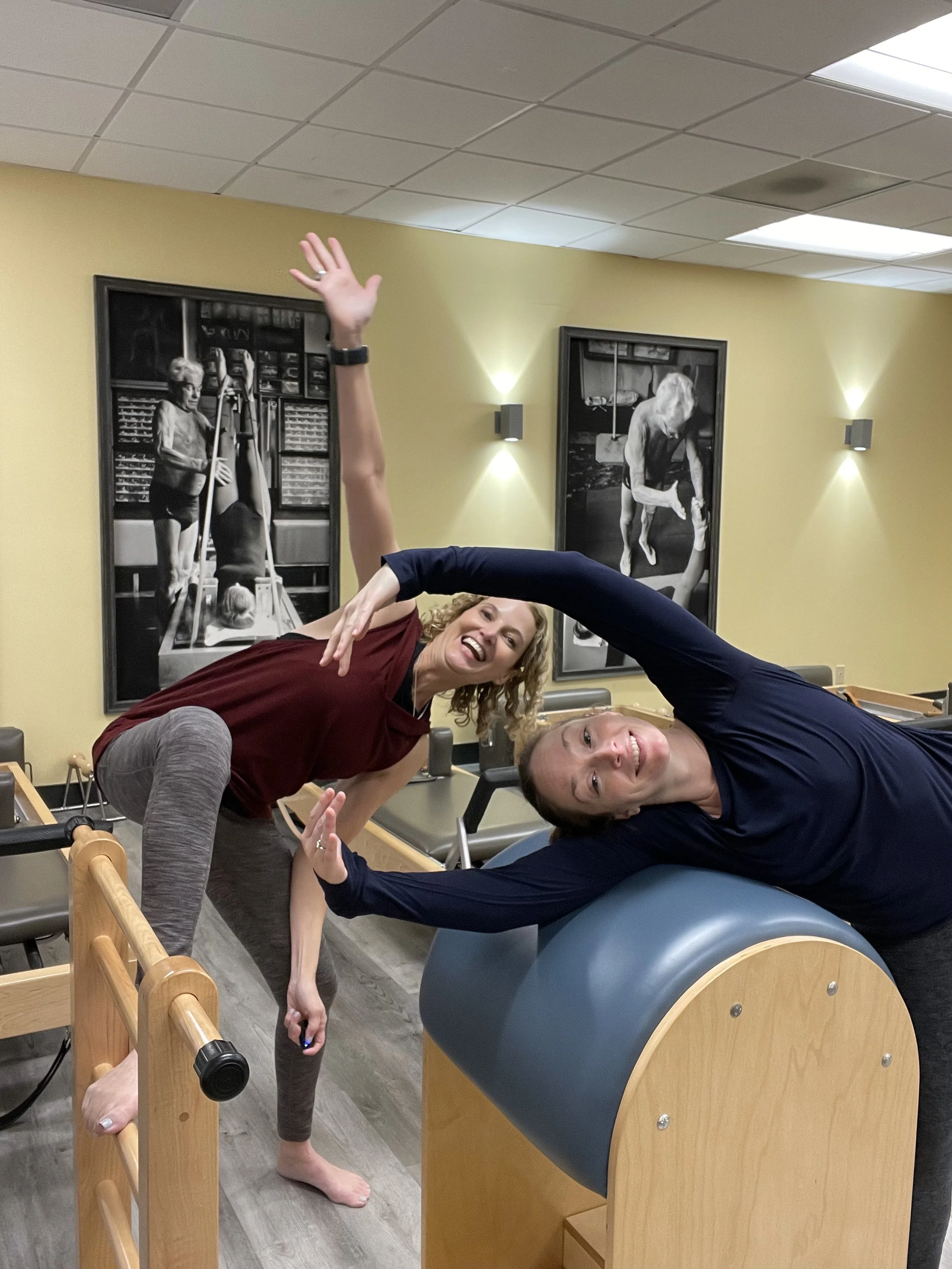To Prop or not to Prop with your Pilates clients
What is the purpose of a prop in Pilates? Why are you using that magic circle or theraband with your Pilates client? Is your Pilates client saying they are bored? Are you worried about that Pilates client getting bored? Why are you using that prop with that Pilates client at that moment?
In our podcast "Be Proppy with Purpose" we discussed the use of props and assistive aids in our Pilates practice. We thought about the inevitable bored client as an example of how or why we may use props, trying to keep someone focused or entertained. The reality is that props aren’t just going to be used because the Pilates teacher thinks the client is bored but, if we think about why, what is the purpose, what am I as a teacher trying to enhance or connect for this client, then it opens up a whole new focus or intent for their practice and the session.
Our props are tools in our teaching toolbox that we use help clients with a certain injury or pathology, to find a connection that is missing for the client in their body or thought process, as well as find better body alignment, proprioception, or symmetry. In looking at props we need to find the right prop for the right reasons for a specific client.
Props are any small device that we use along with our Pilates exercises. These can be various bands, balls, hand weights, magic circles, foam rollers, etc. Assistive aids such as pillows or blocks to use for head lifts or back support are highly beneficial to the client that needs them. Any of these items are tools that can add to our teaching and change and improve a client's experience, but we want to make sure each item is used with purpose, for a specific reason because these items can also become a crutch and hinder a client's practice as well. Props are tools to be used for a client to find new connections and sensations, but it's all about graduating and eventually not needing them, and definitely not relying on them in order to do Pilates.
While props can be used to help a client find a connection in the body, to change an exercise, to add variation, to add support, or to assist with comfort around an injury or pathology. The problem we've noticed is that often teachers get into the habit of using many different props to make exercises more challenging or different in some way, and then become what we call very "proppy". We can get too proppy when we rely on these items to create a deeper connection for clients instead of teaching them how to find it in the movement, but when used with purpose they can also be a great tool.
Using props should have a purpose for the exercise, and that purpose depends on the individual client. We want to think about how this client moves, and what we have seen with them in their session, and then figure out how a certain prop will be helpful for them in terms of their body and placement in order to find what we're looking for from the full range of movement.
The props we use as Pilates teachers should enhance the Pilates work and not take away from the intent of the work for the client. We want to keep the purpose and the why of this exercise and full workout for this client’s body. What we don’t want to do as Pilates teachers is just throw props at the client to see what happens to keep them entertained with variations. We don't want to “throw spaghetti to the wall and see if it sticks!”
When using props you also don’t want to make it a crutch for the client. Think of the prop as something they use and then once the purpose of that prop is realized it is removed. They can then “feel” and “imagine” that prop and learn how to engage, connect, and essentially learn from the prop what and how to do something that was missing for them.
Here are a few reasons you would think about using a prop for a client:
1. Finding some stability in a certain area as they are moving through the work and helping find dynamic stability.
2. If they have had an injury or issue that has affected some movement or range a prop can help them engage and connect again.
3. Helping them find more balance in the body and symmetry in the work of the entire body evenly.
4. Finding proprioception and knowing where something is in space or in the body compared to other parts of the body.
5. To wake up or fire into muscles or movements that are not happening for that client in a movement.
It's always fun to add variations to our practice or to change things up, so we can use a prop to change the focus of an exercise. However, when teachers depend on props continuously we are hindering the client's ability to work through the exercises by connecting through their own body. If a client is taught that they can't do a certain exercise without a head support or a ball, they will mistakenly believe that they are in danger if they attempt the movement without that support. If we always give a client the same prop they may come to rely on it and think they have to use it in order to do Pilates. For some people that can then create a fear of working without the prop, a variation of kinesiophobia, or simply just never understanding how to create that connection for themselves in their practice without the aid of the prop.
It can be quite useful to use an external aid to help a client find a specific connection, but then the prop should be slowly eliminated over more sessions, teaching the body to find that same connection without it. At the same time, it's different when someone needs an assistive aid to accommodate injury or discomfort. We can use small head lifts or towel rolls for clients who get chronic positional vertigo or larger head lifts for clients with severe kyphosis or forward rounding shoulders when they can't lay the head flat on the mat, or as needed when someone has certain chronic neck issues. Sometimes these aids can be eliminated in time, but it's not necessary to force a client to remove a prop that is benefitting them when needed.
However, are we using a prop to keep a client from getting bored? To simply make something more "interesting" or change it up? Or are we using it for a specific reason to assist a goal, and to deepen and increase connections? The prop can make the client feel the connection that may have been missing. The client can then find the connection they couldn't before, so then when the prop is taken away they can create the length and connection for themselves, thus strengthening their physical practice and their understanding of how to move through the body and what they need.
Props are like the springs on the apparatus. it is something for the client to get feedback for their body in ways that are truly specific for that body. Just like our tactile touch in Pilates, we want the props to talk to the client more than our cues for them to find the connections from their own body. The prop can help them understand the cues internally, to figure it out in a way that works for them and their body.
When it comes to bored clients props can be used to get them to dig deeper and focus in ways that are new or different. The props should still have that same purpose and not just be a moment of “squeeze this hard” or that throwing props at them to entertain them. Giving them a prop should get them more engaged in their body and also in their mind as they now have to truly think about what is happening.
Props can also be used to add variety to the Pilates work for clients in terms of not only finding connections but maybe slowing them down or seeing how much they can do and still have control.
An important thing about using props is to not let it become a thoughtless moment of "put that ball here, that band here, or that circle here". It should be a moment for the client to build an understanding of what needs to happen for their body and to develop movement knowledge to be able to get that same work without the prop, realizing and feeling what is happening in the body when that prop WAS there but, now they can make it happen on their own.
In the Pilates studio, we have many apparatus with springs and different orientations to gravity and how that spring and the body feed into each other for that client. Sometimes taking them back to the mat and finding a prop to get something within reach for the client is needed. Once we find that and the prop has woken up whatever we needed for many that prop can go away and the spring now becomes a stronger connection for the client and things that were missing before are now connected by the previous use of the prop.
Another consideration is our neuro clients who have had injuries or strokes, MS, or Parkinson's, where props may be needed for longer periods of time or for the client's continued practice. That doesn’t mean those props again are used as crutches but, to help in the same way for any client, to engage, strengthen, connect, and practice safely in ways that make their daily life and movement improved and more functional for them.
Pilates teachers should not rely on props to “fix” or “entertain” but to use them to enhance, connect and change a thought process or experience in the work for the client. We don't want to be the teacher with their client in the studio throwing as many props as you can at them to keep them working by default of squeezing bands and balls and circles.
To put it simply, props should have a purpose and give the client a new way to find connections to the work, their practice and their body.
When we choose to use a prop remember:
1. Specify the Range of movement to use with it (ex. Don't pulse the ball, squeeze slooooowly)
2. Give the client the boundaries to go up to along with the prop (Only go out where you can maintain x and y)
3. The placement of a prop on the body makes a huge difference to what muscle is activating more (band or ball at the knees vs ankles)
4. We can add a prop to an exercise done many times in order to increase a connection or change sensation.
5. Choose a prop that makes sense for the specific goal of the unique client.
Overall, when choosing to use an extra prop along with our Pilates sessions, we should ask what we are trying to accomplish. It's great to use a prop to make something fun or different, exploring new sensations and new connections, seeing how the addition of something finds different connections and adds variety. But when we just use the prop to keep someone from being bored the prop might be masking a deeper problem, or if we always use it for a certain exercise it may become a crutch that the client relies on or then become fearful of trying it without the added prop. Is it a crutch, or are we helping clients find the connection that we can then graduate them out of needing? Is the prop helping or hindering the practice? Is it even needed?
Make the choice to use something in order to add to a session, not only to seem creative or keep someone entertained, but to use them with purpose, and graduate out of props when possible so the client doesn't become dependent on any one item.
Be proppy with purpose!






